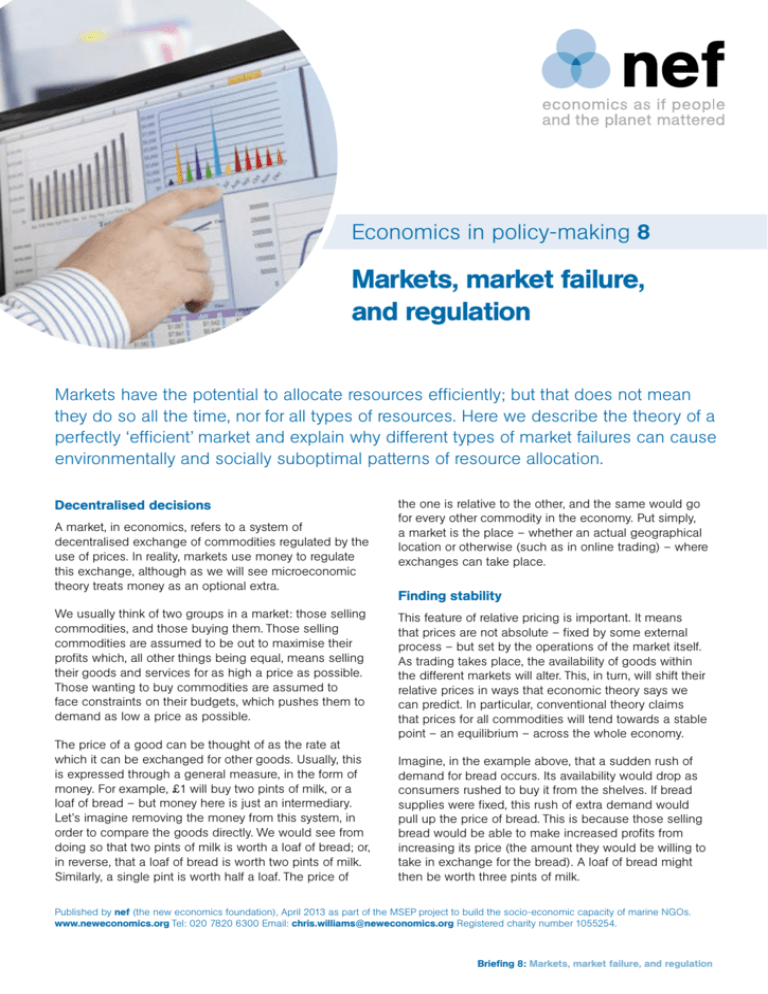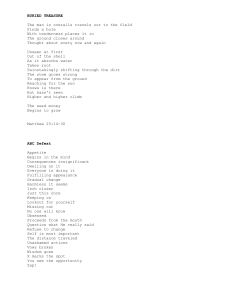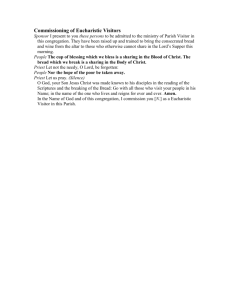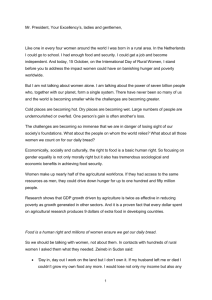Markets, market failure, and regulation
advertisement

Economics in policy-making 8 Markets, market failure, and regulation Markets have the potential to allocate resources efficiently; but that does not mean they do so all the time, nor for all types of resources. Here we describe the theory of a perfectly ‘efficient’ market and explain why different types of market failures can cause environmentally and socially suboptimal patterns of resource allocation. Decentralised decisions A market, in economics, refers to a system of decentralised exchange of commodities regulated by the use of prices. In reality, markets use money to regulate this exchange, although as we will see microeconomic theory treats money as an optional extra. We usually think of two groups in a market: those selling commodities, and those buying them. Those selling commodities are assumed to be out to maximise their profits which, all other things being equal, means selling their goods and services for as high a price as possible. Those wanting to buy commodities are assumed to face constraints on their budgets, which pushes them to demand as low a price as possible. The price of a good can be thought of as the rate at which it can be exchanged for other goods. Usually, this is expressed through a general measure, in the form of money. For example, £1 will buy two pints of milk, or a loaf of bread – but money here is just an intermediary. Let’s imagine removing the money from this system, in order to compare the goods directly. We would see from doing so that two pints of milk is worth a loaf of bread; or, in reverse, that a loaf of bread is worth two pints of milk. Similarly, a single pint is worth half a loaf. The price of the one is relative to the other, and the same would go for every other commodity in the economy. Put simply, a market is the place – whether an actual geographical location or otherwise (such as in online trading) – where exchanges can take place. Finding stability This feature of relative pricing is important. It means that prices are not absolute – fixed by some external process – but set by the operations of the market itself. As trading takes place, the availability of goods within the different markets will alter. This, in turn, will shift their relative prices in ways that economic theory says we can predict. In particular, conventional theory claims that prices for all commodities will tend towards a stable point – an equilibrium – across the whole economy. Imagine, in the example above, that a sudden rush of demand for bread occurs. Its availability would drop as consumers rushed to buy it from the shelves. If bread supplies were fixed, this rush of extra demand would pull up the price of bread. This is because those selling bread would be able to make increased profits from increasing its price (the amount they would be willing to take in exchange for the bread). A loaf of bread might then be worth three pints of milk. Published by nef (the new economics foundation), April 2013 as part of the MSEP project to build the socio-economic capacity of marine NGOs. www.neweconomics.org Tel: 020 7820 6300 Email: chris.williams@neweconomics.org Registered charity number 1055254. Briefing 8: Markets, market failure, and regulation If the market is competitive, suppliers can enter and exit it freely, and determine themselves how much of a product they wish to supply. The increase in the price of bread might spur more suppliers to enter the market, increasing the bread supply. But an increase in the supply of bread, driven by competition, would lead to a decline in its price again, as suppliers competed with each other for sales. In the end, although the total amount of bread available would increase, its price would be driven back down again – to the lowest level at which suppliers would be willing to sell it. This would be at the point at which they just make a profit. Efficient markets This little example illustrates the two features of markets that economists usually think are fundamental. The first is that markets express relative prices, so that the changing demands for (and supplies of) different commodities affects these prices directly. This means markets can be decentralised – requiring no external intervention (by government or anyone else) to operate. This is the idea that the early economist Adam Smith expressed when he talked about the “invisible hand of the market”. The second feature is that if markets are competitive, they will also be efficient. We can see in the bread example that the increase in demand for bread lead, through the actions of relative prices, to an increase in its supply. The extra demand for bread was met while suppliers were still just making a profit: additional profits were ‘competed away’ and consumers, after an initial price increase, still benefitted from a lower price. An economy with perfect competition would be what is called ‘Pareto efficient’. That is, it would distribute goods and services in such a way that it would not be possible to make one person better off without making another person worse off (see glossary in briefing 1). Through the mechanism of shifting relative prices, information would be communicated to suppliers and consumers about the relative desirability and availability of commodities. By allowing prices to shift, and more (or less) supply to be brought to market, the economy would by its own devices generate the best possible outcome. This would not necessarily be the ‘fairest’ or the ‘most desirable’ outcome, but the one that most efficiently allocated all available resources given consumers’ demands. No government intervention could do this better. Market failures Of course, what you’ve just read is the textbook theory. Real life rarely corresponds to it due to what conventional economics calls “market failure”. These failures can occur on either or both sides of the market due to imperfect competition amongst suppliers, badlyinformed market participants, and the unintentional consequences of market operations. 2 Imperfect competition “Imperfect competition” can occur when there are so few suppliers that they can, in effect, set their own prices; and it happens, in particular, when firms are blocked from entering or exiting a market. Monopoly is one cause of such a blockage, whereby a single firm occupies the entire market and prevents others entering to compete. Monopolies can occur ‘naturally’, as when the costs of entering a market are exceptionally high. Major infrastructure businesses often have this character: it would be prohibitively expensive, for example, to build an alternative London Underground to compete with the original. Thus the Underground (like other forms of public transport) forms a monopoly. They can also appear through legal devices, such as patents, which deliberately give the holder a monopoly on use of a new technology. Imperfect information Alternatively, important information may not be well distributed or understood by those within a market. If information is ‘asymmetric’ (unevenly spread across market participants), prices will not properly communicate the real availability of and desire for different commodities. One version of this is ‘adverse selection’, in which those looking to buy a commodity do not know its true qualities, while suppliers are well informed – as in the market for used cars, for example. Alternatively, ‘moral hazard’ can occur, in which a contract specifies future behaviour, but that future behaviour cannot be fully monitored. For example, an employee may decide to shirk in order to avoid costly effort, or someone taking out car insurance may drive more recklessly. Externalities Finally, unintentional consequences can affect markets through what economists call ‘externalities’. These are the consequences of market activities that are not properly priced by the market. Pollution is a classic example: a firm producing goods may pollute the atmosphere, but would not pay for cost of this pollution to the planet and society. As a result, the firm’s production price would not reflect the true social cost of its output. ‘Negative externalities’ like pollution lead to too much of a commodity being produced, relative to the social ideal, since additional costs are ignored by the market. ‘Positive externalities’ work the other way round: someone keeping bees in their garden (for honey) benefits others (through pollination) as well as themselves, and so the supply of bee keepers is lower than the economic ideal. The solution in both cases is to internalise the costs or benefits – making those in markets appreciate the real impact of their activity. Briefing 8: Markets, market failure, and regulation Market failure: a cause for intervention All of the above are examples of market failure. Market failure is generally treated as the only instance in which a government may intervene. Pollution is regulated through quotas and taxes. Employment law regulates labour markets. Licensing helps identify good suppliers for consumers. In each instance, the allocation of resources that a market would achieve alone is not ideal, and so a case for government intervention is created. Most environmental issues have this character. Overfishing and overgrazing, for example, are the product of unregulated markets, in which the negative externality of excessive fishing or grazing is not captured in market prices. Solutions to this might include licensing, nationalisation of producers, or closer regulation of consumer markets. Economics in Policy-making briefings: 1 An overview of economics Sagar Shah 2 How economics is used in government decision-making Susan Steed 3 Valuing the environment in economic terms Olivier Vardakoulias 4 Social CBA and SROI Olivier Vardakoulias 5 Discounting and time preferences Olivier Vardakoulias 6 Multi-criteria analysis Olivier Vardakoulias 7 Beyond GDP: Valuing what matters and measuring natural capital Saamah Abdallah Further reading and useful resources 8 Markets, market failure, and regulation James Meadway Stiglitz, J. (1989), “Markets, Market Failures, and Development,” American Economic Review, 79:2 9a Finance and money: the basics Josh Ryan-Collins Grantham Research Institute (2012), “Why do economists describe climate change as an example of ‘market failure’?”, Guardian, 21 May 2012 Vairan, H. (2006), Intermediate Microeconomics (7th edn.) 9b What’s wrong with our financial system? Josh Ryan-Collins 10 Property rights and ownership models James Meadway 11 Behavioural economics – dispelling the myths Susan Steed The Marine Socio–Economics Project (MSEP) is a project funded by The Tubney Charitable Trust and coordinated by nef in partnership with the WWF, MCS, RSPB and The Wildlife Trusts. The project aims to build socio-economic capacity and cooperation between NGOs and aid their engagement with all sectors using the marine environment. Written by: James Meadway Edited by: Chris Williams Design by: the Argument by Design – www.tabd.co.uk Published by nef (the new economics foundation), April 2013 as part of the MSEProject to build the socio-economic capacity of marine NGOs. www.neweconomics.org Tel: 020 7820 6300 Email: chris.williams@neweconomics.org Registered charity number 1055254. 3 Briefing 8: Markets, market failure, and regulation







